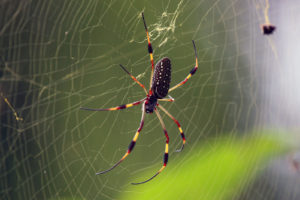Pound for pound, the spokes in a spider’s web beat steel fibers on all counts. “Dragline” silk is stronger (has better tensile strength) and is obviously better at stretching than steel. If fabric could be made from spider silk, body armor would be more protective and parachutes would be lighter and their cords stretchier. Medically, sutures made of spider silk could be thinner and stronger, and have low immunogenicity.

Photo by Charles J. Sharp
But spider farms for harvesting silk don’t exist because spiders are territorial and cannibalistic. A garment made by human ‘milking’ millions of spiders in Madagascar has been displayed in several museums, but this method is obviously not a commercial possibility.
Therefore, for decades materials scientists have been trying to make a synthetic spider silk that can duplicate the real thing.1 Scientists, for example, succeeded by genetic manipulation to have one kind of spider silk secreted into goat milk. Unfortunately, the actual amount of silk produced was too low to be commercially viable.
Continue reading Synthetic Spider Silk: Getting Closer to the Real Thing
